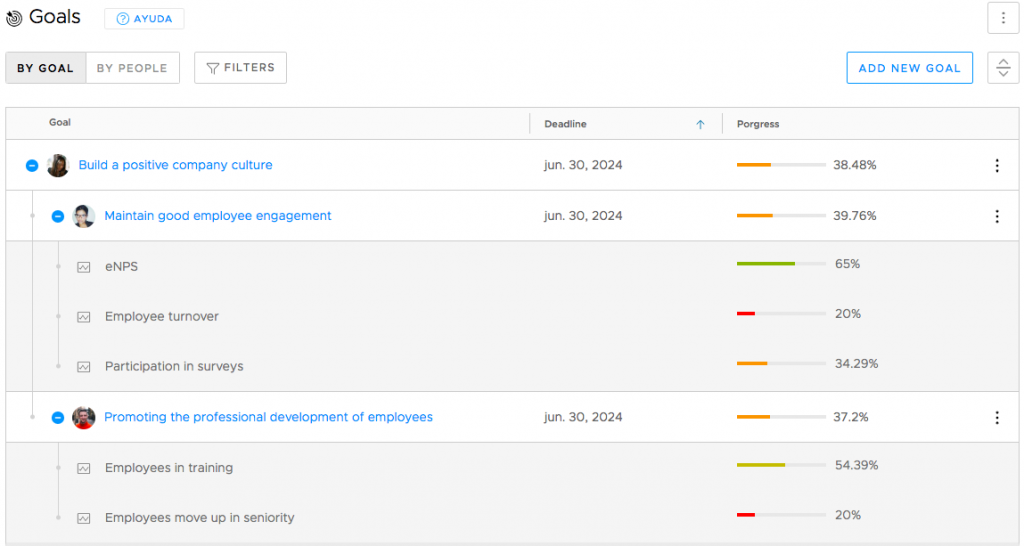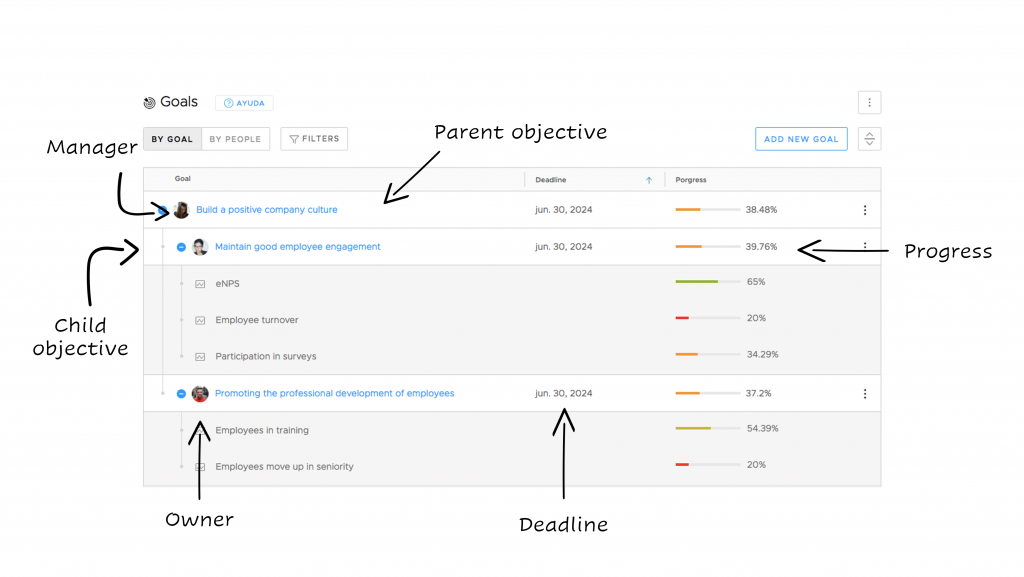Goals management based on OKRs has become very popular in recent years. Especially in marketing, sales, HR, IT and customer service teams, OKRs have been a very interesting way to measure performance. This is not surprising, as the OKR methodology provides the visibility needed for teams to understand how their goals connect with those of others to achieve collective success.
Put like that, it starts to sound like the ideal weapon for creating greater cohesion in teams, isn’t it? 😉
When employees feel that the progress of their goals impacts those of other teammates or even other departments, motivation and commitment to achieve them skyrockets. This is precisely what the OKR methodology is all about: defining an effective way to measure overall goals based on individual measurable factors that reflect the benefits of teamwork.
Let’s go step by step, let’s start with the first thing, what is an OKR and why were OKRs created?
What is an OKR? From Intel to Google, and up to this day
Lately we hear a lot about the term OKR and how startups are adopting this methodology to measure their goals. It has commonly been popularized as a way to measure goals on a small scale, in companies that do not have too many interconnections. But nothing could be further from the truth… The creation of the OKR methodology dates back to the 1970s and its authorship is attributed to Andy Grove, CEO of Intel, no small company, by the way.
We can say that the OKR methodology was born at Intel, but it was undoubtedly reinforced and popularized at Google.
What happened then is that John Doerr, a well-known investor and author of the book “Measure What Matters“, came to Google after his time at Intel. It was at Google that he validated the OKR methodology as a form of management by goals, back in the 1990s.
Doerr’s concept was simple: to achieve big goals you must identify which measurable factors are indispensable to achieving your goal, and measure your performance against them.
Hence its acronym: O (objectives) KR (key results).
Put that way, it’s pretty clear what a teamwork feeling OKRs reflect, isn’t it? It is very likely that its operational efficiency coupled with the motivational boost it provides to employees are the reasons why companies such as Google, LinkedIn and Airbnb make use of this methodology.
What are the benefits of the OKR Methodology?
Considering that very successful companies such as Intel, Google or LinkedIn use this methodology, it is not surprising that the list of benefits it brings is very interesting. The implementation of the OKR methodology in a company helps to:
- Provide clarity on global and individual objectives.
- Orient the work of employees to the achievement of results.
- Improve employee engagement and motivation.
- Reduce employee turnover by providing employees with development opportunities to achieve their objectives.
- Promote transparency in the organization through fluid and continuous communication.
- Align employees and different areas, favoring teamwork.
- Encourage employees to work autonomously based on the prioritization of tasks that help move their key results.
- Optimize internal work processes.
- Give visibility to all employees on the company’s progress.
- Promote a culture of accountability where employees feel responsible for the company’s success.
- Connect employees’ work to the overall goals of the organization.
What is the difference between OKR and KPI?
It is very common to confuse OKRs with KPIs, but the reality is that they are very different. KPIs, as defined by the meaning of their acronym, Key Performance Indicators, measure the performance of a company, team or process, in relation to established goals.
Typically, KPIs are more oriented towards tracking operational indicators, such as time, speed, quality, etc. In addition, they are usually used only at the team level, without impacting the goals of the rest of the company. Whereas OKRs are more closely related to the business and value delivery; with a clear impact on business goals.
How to implement OKRs
As already mentioned, the term OKR refers to Objectives and Key Results. Therefore, we can say that the definition of OKRs has two parts:
- Objectives: what you want to achieve. What the company wants in its most qualitative, visionary and motivating sense. By these parameters you have probably already thought, “How am I going to measure something qualitative, visionary and motivating?” This is where Key Results come into play.
- Key Results: here they are totally quantitative results, i.e., measurable, connected to the progress towards that global objective of a more qualitative nature. For a correct definition of Key Results, we recommend following the methodology applied to SMART goals.
Once we have understood the difference between KPIs and OKRs and we know what the latter is composed of, defining goals takes on a new meaning. To help you create your first OKR, we recommend that you take a look at the examples in the following section and try to compose your own as we define the structure of our examples.
OKR Examples
As mentioned in the previous section, the definition of OKRs is broken down into two: the definition of objectives (O) and the definition of key results (KR). To help you define your own OKRs, let’s look at an example:
- Objective: maintain a good level of employee engagement in the company. At first glance, nothing measurable of course, what is “a good level of employee engagement”? Too subjective and qualitative. So how do we measure it? Well, by defining its key results based on a specific period of time; let’s say the end of the second quarter of the year. periodo de tiempo concreto; pongamos el final del segundo trimestre del año.
- Key Results:
-
- Achieve an eNPS of +55 by the end of the second quarter of the year. Here your KR would be “eNPS” and your target would be “+55”.
- Maintain turnover below 15% by the end of the second quarter of the year. Here your KR would be “employee turnover” and your target “below 15%”.
- Maintain employee participation in surveys at 75%. Here your KR would be “employee participation in surveys” and your target “75%”.
Going one step further in the OKR methodology, you could encompass your objective “Maintain a good level of employee engagement in the company” within a larger one, known as the parent objective, “Build a positive company culture”, for example. In this way your objective would become a child objective and you could define other child objectives that also impact the parent objective, “Drive employee professional development”, for example. This is known as objective nesting.
Thus, your objectives would look as follows:

As you can see in the image, in this example, the People department has a parent objective managed by the team manager, with two child objectives, managed by two members of the same team. Within each child objective we find a series of KRs that help convert both the child objectives and the parent objective into quantitative objectives.
This is how the OKR methodology helps in the management of goals and the visibility of the connection between individual objectives and the overall goals of a team and the company as a whole.
Your OKR template
To standardize the OKR methodology in your company you need a framework that all employees have access to. This framework will allow you to define objectives and allow employees to update their progress while gaining visibility into the OKR progress of their peers.
What is an OKR template?
The OKR template is a reusable guide for the correct implementation of OKRs in your company. This template allows your team to define measurable objectives and follow up on them. Having a common template for all employees will allow the whole company to be aware of the progress of global and individual objectives.
How to create your OKR template
Ideally, you should create your OKR methodology template once and use it for subsequent iterations. Normally OKRs are updated quarter by quarter. Thus, from one quarter to the next, your template should allow you to clone those defined in the previous quarter and include those modifications that the team considers relevant for the new quarter. Note the following:
Your OKRs template should have the following elements:
- Parent objectives (or primary objectives).
- Child objectives (or secondary objectives).
- The person responsible for each objective and key result.
- The manager of each employee.
- The completion date.
- The progress.
Your OKR template should allow you to include the following filters:
- By date: current and expired objectives.
- By assignment: my objectives and objectives of X manager’s direct reports (necessary for managers to track their team’s objectives).
Your OKR template should:
- Update the progress of child objectives when key results (KR) are updated.
- Update the progress of the parent objectives when the child objectives are updated.
Let’s take a look at the example above:

The definition and management of OKRs plays a key role in any organization’s path to success. The OKR methodology enables employees, managers and HR teams to promote professional development, team alignment and the proper pursuit of business goals.
If you are a demanding HR professional and want to implement goal management in your company through the OKR methodology, you can manage your goals and OKRs with Nailted. We help you create your OKRs template, putting all the necessary technology behind it so you don’t have to worry about anything else. In addition, you will have access to an administrator dashboard from which you can have full control over the use and progress of all targets.
Remember that by implementing the OKR methodology in your company you will not only be prioritizing the engagement and motivation of employees, but you will also be orienting the work of the team to the achievement of goals and promoting a culture of responsibility where all employees feel responsible and participate in the success of the company.










